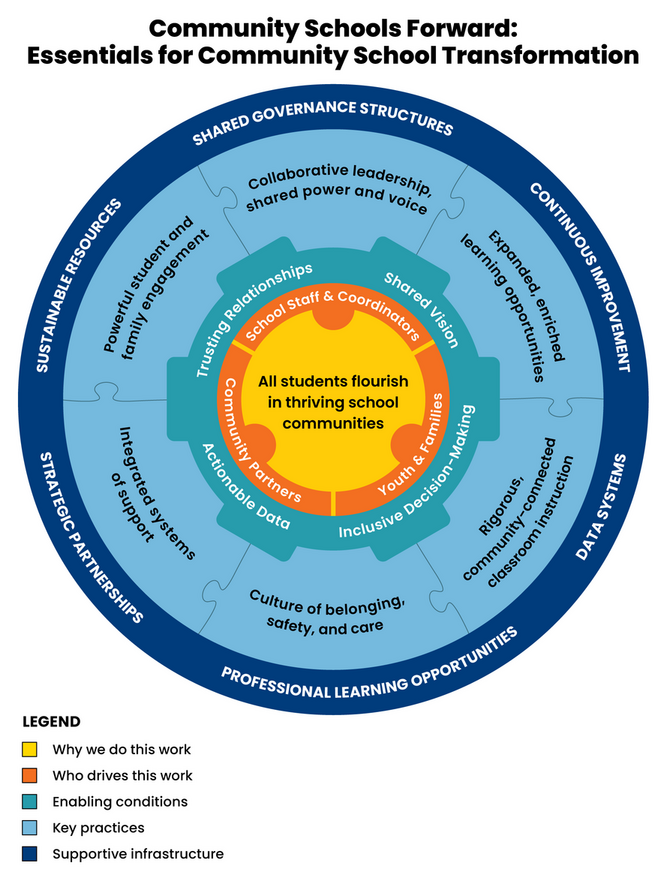The District’s Role in Community School Development

Summary
California is prioritizing equity in education post-COVID-19 by investing in community schools. Districts have an important leadership responsibility to develop the conditions, capacities, and resources for effective, sustainable community schools. Specifically, districts must strengthen system-level supports and infrastructure to ensure sustainable resources, shared governance, robust and usable data systems, and organizational learning and improvement. The district can also support community school coordinators, strengthen data access and sharing, identify and celebrate successful school-site practices, and scale innovations. By taking a cohesive, districtwide approach to community school implementation and sustainability, district leaders can help ensure the success of community school transformation in their districts.
Introduction
As California emerges from the COVID-19 pandemic, there is renewed urgency for understanding and addressing persistent challenges of equity in education. California has seized this moment to invest in strategies that connect the evidence behind the science of learning and development with the demand of educators and community partners to foster high-quality, nurturing, and equitable learning environments. The legislature has made significant investments in community schools as a way to redress historic inequalities and support whole child education both in and out of the classroom. The $4.1 billion budget allocation provides an opportunity for preK–12 public schools across the state to plan and implement community schools through the California Community Schools Partnership Program (CCSPP).1
To support implementation of community schools statewide, the California Department of Education has approved a framework2 that draws on a community-engagement feedback process, the science of learning and development, and a growing research base on community schools. CCSPP funding is being awarded at the district level, with planning grants centrally focused and implementation grants primarily passed through to school sites. In both cases, district leaders have an important role to play in applying for the funding and supporting implementation at multiple school sites across the district. This brief provides guidance for district leaders on approaches to shifting their own leadership to support flourishing community schools. We draw heavily on existing research on Oakland Unified School District (OUSD), which has been operating community schools for more than a decade. In 2011, OUSD became the first full-service community school district in the country.3
What Is a Community School?
Community schools are often misunderstood as student support “programs” or “models” that a school or district may choose to implement, especially to target underresourced and academically low performing school sites. Others conflate community schools with co-located services (e.g., health clinics, food pantries, afterschool care, and family resource centers). Although many community schools do include integrated student and family support services, the ad hoc addition of services to a school site does not necessarily make for a community school.
Rather, a community school strategy commits to a comprehensive teaching and learning environment that educates the whole child; strategically leverages partnerships from within the community; and engages student, family, and community voices in shaping a vision for student success and school priorities. There is not one singular “model” of a community school, as all community schools reflect the diverse communities they represent and serve.
In 2021, four organizations—the Brookings Institution, the Coalition for Community Schools, the National Center for Community Schools, and the Learning Policy Institute— convened the national Community Schools Forward task force to build consensus on defining, understanding, and measuring successful implementation of community schools. Through engagement with more than 1,500 educators, scholars, researchers, and other stakeholders, the task force developed a shared definition and framework4 that articulates the essential elements of a fully implemented community school, including the why, who, and how (see Figure 1). This framework actively engages the four “pillars” of community schools, identified in an earlier report from the Learning Policy Institute,5 and repositions those pillars as part of an integrated strategy for school transformation. This brief focuses on the dark blue “supportive infrastructure” ring that encircles the wheel and the district leadership practices that can advance community school transformation.
Figure 1. Essentials for Community School Transformation

Source. Community Schools Forward. (2023). Framework: Essentials for community school transformation. learningpolicyinstitute.org/project/community-schools-forward. Licensed under the Creative Commons Attribution-NonCommercial 4.0 International License.
What Is the District’s Role in Community School Development?
Community schools have often been implemented on a site-by-site basis as localized endeavors or as small pockets of innovation within larger district systems. Little attention has been paid to the district-level infrastructure and support needed to develop and sustain community schools at scale. As the strategy becomes more widespread, districts are identifying their roles in creating and sustaining the infrastructure that supports the development of community schools. In this brief, we describe 14 practices that leaders in community school districts can implement to foster and develop community schools, whether leaders are starting with a few select schools or strengthening strategies so that all schools in the district operate as community schools. These practices fall under the six aspects of supportive infrastructure necessary for community schools: shared governance structures, strategic partnerships, professional learning opportunities and continuous improvement, data systems, and sustainable resources.
Shared Governance Structures
Collaborative leadership and shared governance are at the heart of the community school approach. Central to both is a collective vision of student success based on “the rich culture, history, geography, and identity of each school community and what they want to be true for their children and families.”6
Facilitate a collaborative visioning and planning process. One of the most important functions of a community school district is facilitating a collaborative visioning and planning process that includes students, families, educators, community partners, and municipal agencies. Many districts may already regularly be doing some form of collaborative visioning and goal setting as part of their accountability requirements. For example, in California, the Local Control Funding Formula (LCFF) requires districts to engage in a collaborative planning process with students and families to identify district goals and priorities. This process has the potential to engage a wider range of municipal organizations and community-based organizations (CBOs) at scale (e.g., city government, the local health system, or a nearby community college), which can provide input, context, and access to resources across the district. A districtwide engagement and planning effort has the potential to access a more coherent picture of community assets, aspirations, and priorities, highlighting areas of similarity and divergence. Rather than amassing multiple site-level visioning and planning processes that may result in either several potentially conflicting plans or one overly broad plan, a districtwide process can create a shared foundation for specific community school sites to build on, adapt, and individualize. This type of deep engagement usually requires substantive administrative capacity; when the district takes on this responsibility, some of the administrative burden for school sites is alleviated.
Spotlight on Practice
In 2010, OUSD kicked off its community school initiative with an 18-month strategic planning process involving 14 task forces and more than 3,500 participants. The result was an in-depth strategic plan—Healthy Schools, Thriving Students—that set the district’s direction for the next 10 years, despite several changes in superintendents during the first 7 years.
Build site-level capacity for collaborative leadership and decision-making. Many school and district leaders recognize the importance of collaborative leadership, but they often struggle with meaningfully engaging the leadership of students, f
- 1The CCSPP is one of multiple whole child funding streams, including Universal Transitional Kindergarten, the Expanded Learning Opportunities Program, and the Child and Youth Behavioral Health Initiative, allocated in fiscal year 2021–22.
- 2California Department of Education. (2022). California community schools framework [Microsoft Word document]. cde.ca.gov/ci/gs/hs/documents/ccsppframework.docx
- 3McLaughlin, M., Fehrer, K., & Leos-Urbel, J. (2020). The way we do school: The making of Oakland’s full-service community school district. Harvard Education Press; Klevan, S., Daniel, J., Fehrer, K., & Maier, A. (2023). Creating the conditions for children to learn: Oakland’s districtwide community schools initiative. Learning Policy Institute. doi.org/10.54300/784.361
- 4The Community Schools Forward task force also produced a theory of action, a costing tool, an outcomes and indicators tool, and a technical assistance needs assessment report for community schools.
- 5Oakes, J., Maier, A., & Daniel, J. (2017, June 5). Community schools: An evidence-based strategy for equitable school improvement. Learning Policy Institute. learningpolicyinstitute.org/product/community-schools-equitable-improvement-brief
- 6Sarikey, C. (2022). Community schools: A journey for collective success. Community Schooling, 2. communityschooling.gseis.ucla.edu/journal-issue-2-policy
Fehrer, K., Myung, J., & Kimner, H. (2023, June). The district's role in community school development [Policy brief]. Policy Analysis for California Education. https://edpolicyinca.org/publications/districts-role-community-school-development